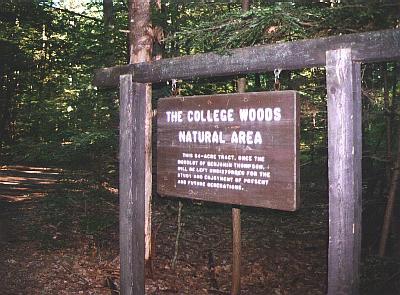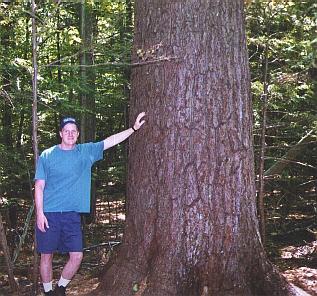
The College Woods Natural Area. This 64-acre tract, once the woodlot of Benjamin Thompson, will be left undisturbed for the study and enjoyment of present and future generations.
Introduction
College Woods is located on the west side of the main campus. It comprises approximately 250 acres of woods, streams, and small fields. College Woods is the oldest and most intensively used University property for education, research and recreation. It is not uncommon to see walkers, runners, and classes all in one brief stroll through the woods.
History
The original land was donated by Benjamin Thompson, Jr. to New Hampshire College of Agriculture and the Mechanical Arts (the predecessor to the University of New Hampshire) via his will in 1891. This donation was part of the original gift that moved the College to Durham from Hanover where the College was connected to Dartmouth College.
All of College Woods has been cut at least once. Wood from these areas was used to build some of the earlier college's structures. Most of these building no longer exist. Nevertheless, in some instances, the woodlots that provided this wood still do. One building containing timber from College Woods is Morrill Hall, constructed in 1903.
The woods have been encroached upon by University building expansion since it was donated to the College. In 1933 the University, in conjunction with the town cut out a large portion of College Woods for the Oyster River Reservoir. This was done because of a need for a bigger water supply. It is alleged that some of Ben Thompson's largest trees were cut at this time. Although some smaller harvests have occurred just south of Channel 11 and between Mill Road and the reservoir, the last major operation was the salvage of timber from within the Natural Area immediately following the hurricane of 1938.

This picture was taken in May 1998 at the "Paul Bunyan" a 50.5" DBH eastern white pine located in the College Woods Natural Area.
Present Use
Presently, some 60 acres within the main woods area is designated as a Natural Area. This designation places these stands in a preservation status. This area was designated in 1961. Since this time nothing has been done to alter natural process within the Natural Area. Dead or dying trees have only been removed when they pose a hazard to trail traffic and safety.
Recreational activities occurring within the entire College Woods are hiking, walking, skiing, jogging, bird watching, and general relaxation. Biking is allowed outside of the Natural Area. Hunting is not allowed in any areas of College Woods.
Occasionally, timber harvests are conducted in areas outside the Natural Area to fulfill specific management objectives. These harvests are used to create areas to support specific educational and research activities.
The following activities are presently registered as in progress in College Woods:
- Orienteering Events (Recreational and Instructional)
- Tree boring labs (Instructional)
- Natural resource processes labs (Instructional)
- Passive vegetative sampling (Research)
- Long-term hydrology studies (Research)
- White pine growth & yield studies (Research)
- Physical education classes (Instructional)
- Low impact Army and Air Force ROTC activities (Instructional)
- Permanent rainfall & litter plots (Instructional)
- Vegetation identification labs (Instructional)
Directions
If you are walking: From the Wildcat cross Main Street to get on to College Road. Turn right onto Colovos Road. After passing underneath the railroad tracks go left. After passing over College Brook the main entrance to College Woods will be on your right.
If you are driving: Start as above but continue past Colovos Road and instead take the next right onto South Drive. Once under the railroad tracks take a right, the main entrance will be on your left. Please note parking rules on campus are very specific. Note that there are alternate parking areas on Mill Road that may be used for access that do not follow the same on-campus restrictions.
APPROXIMATE LOCATION: N 43°08.178', W 70°56.266'